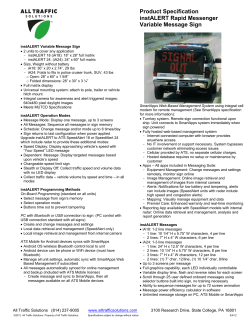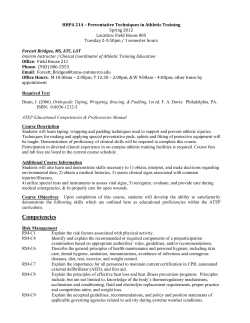
CET
3350 Scott Blvd., Bldg. 55. Unit 1 Santa Clara, CA 95054 USA Voice: 408/988-1346 | Fax: 408/988-4869 URL: http://www.powercet.com E-mail: consulting@powercet.com Sample Consulting Report ATS Transfer Testing with Chiller’s Operational Data Center One Background The purpose of the testing is to determine if any undesirable transient conditions are injected into the electrical distribution or loads during a fast synchronous transition operation of the Automatic Transfer Switch (ATS) associated with the chiller equipment operating at the Data Center One facility. Methodology / Technical Approach Two Dranetz-BMI PowerGuide 4400s were installed as shown in Figure 1 below. Each of the PG4400’s was connected to the load side of the ATS with the 4th channel of monitor #1 connected to the utility supply on the line side of the ATS and the 4th channel of monitor #2 connected to the line side of the emergency source for the ATS. This configuration provides information relative to the power being supplied to the chillers under any source condition as well as documenting the phase relationship between the sources at the time of transfer. Figure 1 – Power monitor ATS test configuration. Date: 7/19/2007 Filename: Sample_ATS_Testing_Report.doc Page 1 of 10 Sample Report PowerCET Corporation Key Findings Introduction During the test window the power source for the chillers was transferred a total of four times—utility to generator, generator to utility and then the sequence was repeated. The following sections document each of the four transfers. The transfer from utility power is generally not a problem unless there is a significant phasing issue as the power source impedance of the generators is significantly higher than the utility service and limits the surge currents. Also the transfer from utility to generator, under test conditions, is an artificial condition. In the case of an actual utility power interruption the generators would not be on so most of the rotating equipment would have had time to decay and the soft-starts would re-engage for the restart of the equipment after the generators are brought on-line. The transfer from generator power to utility is generally when operational problems are experienced. In the case of a short duration transfer the phase synchronization of the generator to the utility is critical. Any significant mismatch in the phase relationships can result in very high peak surge currents which the utility service, unlike the generator, is capable of supplying. The actual ATS transfer is basically a three-cycle event. • • • The initiation cycle is the point at which the synchronization (phase relationship) between the utility and generator are within the ATS’s programmed window and the transfer is enabled. The open cycle is the period that the ATS wiper is moving from Source 1 (S1) to Source 2 (S2) and prior to closing on the new source. The closing cycle is the point at which the new source is physical connected to the load. During the testing the transfer open period varied between 30ms and 38ms which is about as fast as the mechanical ATS can transfer. Some ATS equipment has a neutral (intermediate) position for the wiper which allows for variable open delays to be programmed. The ATS wiper is actually paused in the neutral position before closing on the alternate source. Date: 7/19/2007 Page 2 of 10 Sample Report ATS Transfer Testing Data Center One Transfer #1: Utility to Generator Figure 2 (below) shows the first transfer from utility-to-generator with a 2° phase difference between the two power sources at the time transfer is initiated. The phase drift during the open transition can be seen in figure 4 on the voltage waveforms (upper trace)…gray (Va-b generator voltage) and brown ATS load Va-b. Total open period was approximately 31.2ms. (Note: The inrush current at the time the ATS recloses on the new power source over-ranged the 3000A current probes.) Event Details/Waveforms BOA3_070429 750 500 C-AV 250 Volts CI 0 -250 BI DI A-BV -500 DV -750 A -B Generator V A-B V B-C V C-A V 525 AI 500 Volts B-CV 475 450 Phase B C 425 A -B V Generator V rms (val) A -B Vr ms (val) B-C V rms (val) C-A Vr ms (val) 5000 4000 3000 2000 Amps A D 358° V A 298° 179° 55° 307° A- B B- C C- A 240° 120° V 0° Magnitude A B C D 487.8 V A 863.5 898.6 882.2 17.15 A- B B-C C- A V 476.5 477.6 474.6 1000 0 -1000 31.243 ms -2000 -3000 -4000 -5000 AI BI CI Ph A Generator I 3000 2500 Amps 2000 1500 1000 500 0 A Irms (val) 01:06:43.50 04/29/2007 Sunday 01:06:43.52 B Irms (val) 01:06:43.54 C Irms (val) Ph A Gener ator Ir ms ( val) 01:06:43.56 01:06:43.58 01:06:43.59 Event #4 at 04/29/2007 01:06:43.508 Figure 2 - Transfer from utility to generator. Channel DV is connected between phases A-B of the generator and channel DI’s current probe is connected to generator phase A. Date: 7/19/2007 Page 3 of 10 Sample Report ATS Transfer Testing Data Center One Transfer #2: Generator to Utility Figure 3 (below) shows the first transfer from generator-to-utility with a 2° phase difference between the two power sources at the time transfer is initiated. The phase drift during the open transition can be seen in figure 3 on the voltage waveforms (upper trace)…gray (Va-b utility voltage) and brown ATS load Va-b. Total open period was approximately 31.0ms. (Note: The inrush current at the time the ATS recloses on the new power source over-ranged the 3000A current probes.) Event Details/Waveforms BOA1_070429 750 C-AV 500 250 Volts CI 0 -250 DI BI -500 DV -750 A-BV DV A -B V B-C V C-A V 490 480 AI 470 460 Volt s B-CV 450 440 V A 297° 176° 49° A- B B- C C- A 238° 119° V 0° Magnitude A B C 430 420 D 2° 297° D 486.0 V A 748.8 876.8 804.1 15.38 A-B B- C C- A V 477.9 478.5 462.9 410 D V rms (val) A -B Vrms (val) B-C V rms (val) C-A Vr ms (val) 5000 4000 3000 2000 1000 Amps A Phase B C 0 -1000 31.025 ms -2000 -3000 -4000 -5000 AI BI CI DI 3000 2500 Amps 2000 1500 1000 500 0 A Irms (val) 01:14:36.35 04/29/2007 Sunday B Irms (val) C Irms (val) D Irms (val) 01:14:36.40 01:14:36.45 Event #11 at 04/29/2007 01:14:36.357 Figure 3- Transfer from generator to utility. Channel DV is connected between phases A-B of the utility supply and channel DI’s current probe is connected to utility supply phase A. Date: 7/19/2007 Page 4 of 10 Sample Report ATS Transfer Testing Data Center One Transfer #3: Utility to Generator Figure 4 (below) shows the second transfer from utility-to-generator with a 1° phase difference between the two power sources at the time transfer is initiated. The phase drift during the open transition can be seen in figure 4 on the voltage waveforms (upper trace)…gray (Va-b generator voltage) and brown ATS load Va-b. Total open period was approximately 37.9ms which was about 7ms longer than any of the other open intervals measured during the testing. (Note: The inrush current at the time the ATS recloses on the new power source over-ranged the 3000A current probes.) Event Details/Waveforms BOA3_070429-2 500 C-AV Volts 250 CI 0 -250 DI -500 DV BI DV A-BV A -B V B-C V C-A V 500 490 AI 480 470 Volts 460 B-CV 450 440 430 420 V A 304° 190° 45° A- B B- C C- A 238° 119° V 0° Magnitude A B C 410 400 D V rms (val) D 1° 304° A -B Vrms (val) B-C V rms (val) C-A Vr ms (val) 5000 4000 3000 2000 Amps A Phase B C D 488.2 V A 251.9 424.3 389.8 15.34 A-B B- C C- A V 442.8 446.0 429.9 1000 0 -1000 37.929 ms -2000 -3000 -4000 -5000 AI BI CI DI 3500 3000 Amps 2500 2000 1500 1000 500 0 A Irms (val) 02:07:44.06 04/29/2007 Sunday 02:07:44.08 B Irms (val) 02:07:44.10 C Irms (val) D Irms (val) 02:07:44.12 02:07:44.14 02:07:44.16 Event #3 at 04/29/2007 02:07:44.083 Figure 4 – Transfer from utility to generator. Channel DV is connected between phases A-B of the generator and channel DI’s current probe is connected to generator phase A. Date: 7/19/2007 Page 5 of 10 Sample Report ATS Transfer Testing Data Center One Transfer #4: Generator to Utility Figure 5 (below) shows the first transfer from generator-to-utility with a 2° phase difference between the two power sources at the time transfer is initiated. The phase drift during the open transition can be seen in figure 5 on the voltage waveforms (upper trace)…gray (Va-b utility voltage) and brown ATS load Va-b. Total open period was approximately 31.4ms. Prior to this test the 3000A current probes were exchanged for 6000A probes which allowed the peak inrush currents to be fully displayed. The table in figure 5 summarizes the MIN/MAX readings for each of the traces. Please note that values for waveform plots reflect peak values and the time plot represents RMS values for the above waveform in each of the graphs. Event Details/Waveforms BOA1_070429-2 C-AV 500 DI DV BI Volts CI 250 0 -250 -500 A-BV AI DV D 485.0 V A 699.4 821.1 825.0 14.38 A- B B- C C- A V 472.7 473.5 462.2 M in M ax -686.4 687.9 DV -681.1 681.0 A-BV -681.2 681.1 B-CV -681.0 681.5 C-AV -1758 6432 AI -5371 2822 BI -4955 2628 CI -1730 6338 DI 466.3 485.3 DVrms A-BVrms 415.0 483.2 B-CVrms 426.8 483.7 C-AVrms 422.4 483.1 3.926 3807 AIrms 8.164 3169 BIrms 13.03 2829 CIrms 7.530 3765 DIrms Volts V A 297° 182° 52° A- B B- C C- A 239° 120° V 0° Magnitude A B C B-C V C-A V 500 D 3° 298° 475 450 425 D Vrms (val) A-B Vrms (val) B-C Vrms (val) C-A Vrms (val) 5000 Amps Phase B C 2500 0 -2500 31.420 ms -5000 AI BI CI DI 3500 Amps A A-B V 525 B-CV 2500 1500 500 0 A Irms (val) 02:16:37.30 04/29/2007 Sunday 02:16:37.32 B Irms (val) 02:16:37.34 C Irms (val) 02:16:37.36 D Irms (val) 02:16:37.38 02:16:37.40 Event #300 at 04/29/2007 02:16:37.324 Figure 5 - Transfer from generator to utility. Channel DV is connected between phases A-B of the utility supply and channel DI’s current probe is connected to utility supply phase A. Date: 7/19/2007 Page 6 of 10 Sample Report ATS Transfer Testing Data Center One Additional Discussions Figure 6 is a waveform capture documenting the phase drift between the two different power sources. Once the ATS receives the signal to transfer the synchronizing circuitry monitors the phase relationships between the respective power sources and does not initiate (enable) transfer until the phase difference is within a specified window. In some of the more sophisticated synchronous transfer equipment there is a feedback signal to the generator. The slew rate for the generator/ATS configuration tested appears to be about 60-cycles long (6°/cycle). Event Details/Waveforms DV 500 A-BV Phase D V 119° A-B V 0° Magnitude D V 485.3 A- B V 481.0 Volts 250 0 -250 -500 02:08:05.9 04/29/2007 Sunday 02:08:06.0 DV 02:08:06.1 02:08:06.2 A-B V Event #150 at 04/29/2007 02:08:06.008 Figure 6 – Waveform capture showing phase drift between the utility source A-BV and the generator source DV. Date: 7/19/2007 Page 7 of 10 Sample Report ATS Transfer Testing Data Center One Sample Report ATS Transfer Testing Data Center One Prior to disconnecting the monitoring equipment the thresholds were adjusted to capture the current waveform envelop, figure 7, as the chiller spins-down. The white boxes document the time for the respective segment in the current envelope. Event Details/Waveforms 1000 56.161 Amps 00:00:10.143651 500 Amps 00:00:23.706510 0 00:00:33.878633 -500 -1000 CI 02:45:20 04/29/2007 Sunday 02:45:30 02:45:40 Event #441 at 04/29/2007 02:46:19.547 Timed Figure 7 – Chiller spin-down current waveform envelop. Date: 7/19/2007 Page 8 of 10 Summary / Recommendations The ATS testing did not reveal any significant transients being generated as a result of switching between power sources. The open period experienced during the transfer operation was between 30ms and 38ms which is about as fast and the mechanical ATS can switch between sources. The phase synchronization at the time transfer was initiated was between 1° and 3° degrees with a slew rate of about 6° per cycle. At the closing cycle of the ATS operation, when the load is connected to the new source, an inrush current is generated with peak values between 6000Apeak and 7000Apeak which corresponds to RMS values of between 3000Arms and 4000Arms maximum. These peak values may not be all that different from levels that would be experienced during start of the chillers. (Note: These values are for combined operation of two chillers that were in operation during the testing.) While the testing indicates no significant problems with this type of operation there is always a risk associated with switching large loads between sources. The Data Center One facility appears to have an ATS/Generator configuration with a narrow phase synchronization window and in the four instances measured initiated transfer with a very small phase angle difference. If the equipment can maintain this level of operation then the worse case peak surge currents should be in the range measured in the testing. Some ATS equipment has the ability to send a turn-off signal to selected equipment prior to initiating the transfer that allows rotating equipment to shutdown, allowing the soft-starts to be re-engaged. This method of operation would be preferred as the equipment can be restarted (sequenced-ON) after the successful transfer to the new source. The advantage of this type of operation is that there is little, if any, danger of equipment being connected to an out-of-phase source and, secondly, the loads can be sequenced so that multiple loads are not competing for start-up energy at the same time from the new source. The sequencing of loads on to a new source is common practice in many applications. Generally benign loads are connected first—lighting being a good example—and followed by more critical load—elevators, HVAC, UPS, etc. RECOMMENDATION: Investigate the feasibility of implementing an automatic shutdown of the chillers (and other critical equipment) prior to the initiation of a transfer followed by a sequenced restart to avoid any possibility of out-of-phase transfers and to limit current rush on the new power source. Data Center One conducts preemptive transfer to emergency generator power when certain weather related conditions are present—i.e., thunderstorm activity in the immediate area. The preemptive transfer practice is not all that uncommon for critical installations…DHS, NASA (Johnson Space Center) and Charles Schwab are examples of organizations that practice preemptive transfers to emergency (generator) power. The preemptive transfer practice significantly increases the number of operations for all the electrical switching equipment involved. Conventional ATS equipment was never intended for this frequency of usage and accelerated equipment aging and degradation can be expected. The surge currents, even for a well synchronized break-before-make transfer can be substantial as demonstrated by the 6000 to 7000 peak amp currents recorded during the testing at the Data Center One facility. If the intention is to implement a regular pre-emptive transfer to emergency (generator) power during weather related events then consideration should be given to upgrading the facility to a synchronous Date: 7/19/2007 Page 9 of 10 Sample Report ATS Transfer Testing Data Center One (paralleling) make-before-break type of transfer which will result in substantially reduced surge currents and decreased over stressing of the electrical equipment supporting the Data Center One facility. RECOMMENDATION: Investigate the feasibility of implementing a synchronous, paralleling, makebefore-break type of system for the Data Center One facility. Prepared by: Bruce Lonie President, PowerCET Corporation Date: 7/19/2007 Page 10 of 10 Sample Report ATS Transfer Testing Data Center One
© Copyright 2025
















